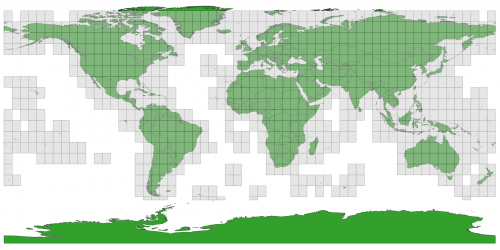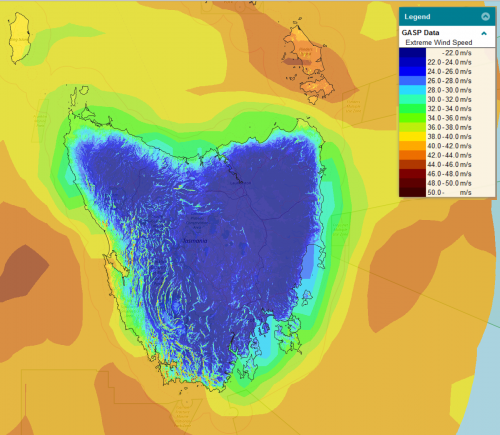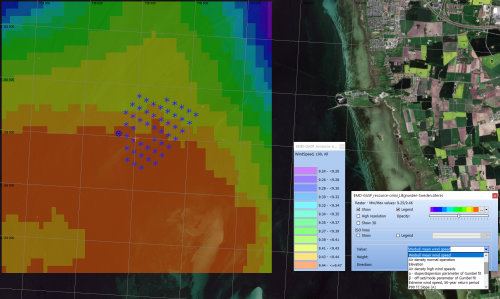GASP Global: Difference between revisions
| Line 329: | Line 329: | ||
|iecr_flsw_txt | |iecr_flsw_txt | ||
|IEC Recommendation (with wakes) – fatigue limit state (FLS) - text | |IEC Recommendation (with wakes) – fatigue limit state (FLS) - text | ||
| | |||
|lon, lat, h | |||
|- | |||
|} | |||
{| class="wikitable" | |||
|+ align="bottom"|Table: Turbine Design Parameters – Extreme Loading [turbine-extreme] | |||
!Variable | |||
!Description | |||
!Unit | |||
!Dimensions | |||
|- | |||
|ulsidx | |||
|IEC Class Recommendation – fatigue limit state (FLS) - id | |||
| | |||
|lon, lat, h | |||
|- | |||
|ulsidx | |||
|Design load index for ultimate limit state (ULS) | |||
|% | |||
|lon, lat, h, wcl | |||
|- | |||
|} | |||
{| class="wikitable" | |||
|+ align="bottom"|Turbine Design Parameters – Fatigue Recommendations [turbine-extreme-recommend] | |||
!Variable | |||
!Description | |||
!Unit | |||
!Dimensions | |||
|- | |||
|ulsidx | |||
|IEC Class Recommendation – fatigue limit state (FLS) - id | |||
| | |||
|lon, lat, h | |||
|- | |||
|iecr_uls_id | |||
|Design load index for ultimate limit state (ULS) | |||
| | |||
|lon, lat, h | |||
|- | |||
|iecr_uls_txt | |||
|IEC Class Recommendation – ultimate limit state (ULS) – text | |||
| | | | ||
|lon, lat, h | |lon, lat, h | ||
Revision as of 18:16, 8 June 2021



Introduction
"GASP Global" is short for "GASP 1.0 - Global of Atlas of Siting Parameters". It is a global atlas dataset with the following key features:
- Global 250m wind resources, siting parameters & turbine design classification
- Builds on GWA3.0 and other sources
- A joint project by EMD and DTU
Dataset Overview
- Spatial coverage:
- Onshore: Near global (all land areas from N80 to S58)
- Offshore: Areas are covered up to 200 km from the coastline
- Resolution:
- Horizontal: 250m in grid resolution
- Vertical: 50m, 100m and 150m as vertical levels
- Data-type: Atlas
- Coordinate system: Geographical coordinates (EPSG: 4326) in original data
- Version: 1.0
Availability from within EMD software
- windPRO: Click 'Data' -> 'Siting parameters (GASP etc)' to access the download tool. Data is loaded into a result layer with a .siteres file acting as the data-container.
- windPROSPECTING: GASP data is available through the data-tab named 'Site-prospecting'. Free access to windPROSPECTING - here.
- EMD-API: Read more at the dedicated wiki-page for our Global Atlas Data Services - here. If you are accessing the GASP data from within the EMD-API, you will use the parameter group-names in order to request specific data-packages [resource-omni, resource-sector, siting-extremes, siting-fatigue-omni, siting-fatigue-sector, turbine-fatigue, turbine-fatigue-recommend, turbine-extreme, turbine-extreme-recommend].
Parameters and Dimensions
As seen from the tables below, a very wide range of omnidirectional and sectorwise parameters are available from the Global Atlas of Siting Parameters (GASP). These parameters have been divided into four main categories:
- Wind Resources / Atmospheric Parameters
- Siting Parameters – Fatigue
- Siting Parameters – Extremes
- Turbine Design Classification - with recommended turbine class
The tables below provides an overview of all parameters available and at which dimensions that they are available. We have used the following dimensions for the GASP parameters: The first four (longitude, latitude, height and sector) are used for the basic parameters; the last three (ws_class, iec_class and turbine_component) are used for the turbine design classification - and are releated to the IEC61400-1 code and the aeroelastic load model. Please note that not all dimensions are relevant or used for every GASP parameter.
| Dimension | Abbreviation | Unit | Range |
|---|---|---|---|
| longitude | lon | deg | 180 to -180 |
| latitude | lat | deg | 90 to -90 |
| height | h | m | 50,100,150 |
| sector | s | deg | 0,30,...,330 |
| ws_class | wcl | I,II,III,T | |
| iec_class | iecc | IA+, IA,...IIIC | |
| turbine_component | tc | 0,1,2,3 |
Parameters: Wind Resources
The two tables below show the GASP parameters for wind resources data, given omnidirectional data [resource-omni] and sectorwise data [resource-sector].
| Variable | Description | Unit | Dimensions |
|---|---|---|---|
| weib_A | Wind distribution: A (Scale) parameter in Weibull distribution | m/s | lon, lat, h |
| weib_k | Wind distribution: k (shape) parameter in Weibull distribution | lon, lat, h | |
| wsp | Wind speed - annual average | m/s | lon, lat, h |
| wpd | Wind power density – annual average | W/m2 | lon, lat, h |
| air_dens | Air density (annual mean/average) | kg/m3 | lon, lat, h |
| Variable | Description | Unit | Dimensions |
|---|---|---|---|
| weib_A | Wind distribution: A (Scale) parameter in Weibull distribution | m/s | lon, lat, h, s |
| weib_k | Wind distribution: k (shape) parameter in Weibull distribution | lon, lat, h, s | |
| sector_freq | Wind distribution: Sector frequency | lon, lat, h, s | |
| wsp | Wind speed - annual average | m/s | lon, lat, h, s |
| wpd | Wind power density – annual average | W/m2 | lon, lat, h, s |
| air_dens | Air density (annual mean/average) | kg/m3 | lon, lat, h |
| elevation | Air density (annual mean/average) | kg/m3 | lon, lat, h |
Parameters: Siting Classification - Wind Extremes
The table below shows the GASP parameters for the extreme event data [siting-extremes]. Please note that this extreme data is only available as omnidirectional parameters.
| Variable | Description | Unit | Dimensions |
|---|---|---|---|
| air_dens_p98 | Air density at 98th percentile of wind speed | kg/m3 | lon, lat, h |
| wsp_50yr | 50yr extreme wind speed: Average | m/s | lon, lat, h |
| gumbel_alpha | 50yr extreme wind speed: Gumbel distribution – alpha parameter | m/s | lon, lat, h |
| gumbel_beta | 50yr extreme wind speed: Gumbel distribution – beta parameter | m/s | lon, lat, h |
Parameters: Siting Classification - Wind Fatigue Parameters
The two tables below show the GASP parameters for the siting-fatigue parameters - given either omnidirectional or sectorwise data-requests [siting-fatigue-omni, siting-fatigue-sector].
| Variable | Description | Unit | Dimensions |
|---|---|---|---|
| shear_exp | Wind shear exponent (calculated using LINCOM model) - Mean | lon, lat, h | |
| flow_inc | Flow inclination (calculated using LINCOM model) | deg | lon, lat, h |
| terrain_ic | Terrain complexity as defined in IEC 61400-1 standard (ed 4) | lon, lat, h | |
| sigma_P90A | Turbulence slope parameter from IEC 61400-1 (ed4) – P90 | lon, lat, h | |
| sigma_P90B | Turbulence offset parameter from IEC 61400-1 (ed4) – P90 | m/s | lon, lat, h |
| sigma_P90U15 | Turbulence P90 at a fixed windspeed of 15 m/s | m/s | lon, lat, h |
| air_dens | Air density (annual mean/average) | kg/m3 | lon, lat, h |
| Variable | Description | Unit | Dimensions |
|---|---|---|---|
| shear_exp | Wind shear exponent (calculated using LINCOM model) - Mean | lon, lat, h, s | |
| flow_inc | Flow inclination (calculated using LINCOM model) | deg | lon, lat, h, s |
| sigma_meanA | Turbulence slope parameter from IEC 61400-1 (ed4) – Mean | m/s | lon, lat, h, s |
| sigma_meanB | Turbulence offset parameter from IEC 61400-1 (ed4) – Mean | m/s | lon, lat, h, s |
| sigma_P90A | Turbulence slope parameter from IEC 61400-1 (ed4) – P90 | lon, lat, h, s | |
| sigma_P90B | Turbulence offset parameter from IEC 61400-1 (ed4) – P90 | m/s | lon, lat, h, s |
Parameters: Turbine Design – Loads
The four tables below show the GASP parameters for the turbine design classification. Two main groups are fatigue and extreme load cases, then divided into four data-groups so requests is possible for turbine load indexes and iec class recommendations: [turbine-fatigue, turbine-fatigue-recommend, turbine-extreme, turbine-extreme-recommend].
| Variable | Description | Unit | Dimensions |
|---|---|---|---|
| flsidx | Load index for the fatigue limit state | % | lon, lat, h, iecc, tc |
| flsidx_w | Load load index for the fatigue limit state with wakes | % | lon, lat, h, iecc, tc |
| tc_woehler | Turbine component (tc): Wöhler exponent used | lon, lat, h, iecc, tc | |
| tc_name | Turbine component (tc): Name | lon, lat, h, iecc, tc | |
| tc_sensor | Turbine component (tc): Sensor name | lon, lat, h, iecc, tc |
| Variable | Description | Unit | Dimensions |
|---|---|---|---|
| iecr_fls_id | IEC Class Recommendation – fatigue limit state (FLS) - id | lon, lat, h | |
| iecr_fls_txt | IEC Class Recommendation – fatigue limit state (FLS) - text | lon, lat, h | |
| iecr_flsw_id | IEC Recommendation (with wakes) – fatigue limit state (FLS) - id | lon, lat, h | |
| iecr_flsw_txt | IEC Recommendation (with wakes) – fatigue limit state (FLS) - text | lon, lat, h |
| Variable | Description | Unit | Dimensions |
|---|---|---|---|
| ulsidx | IEC Class Recommendation – fatigue limit state (FLS) - id | lon, lat, h | |
| ulsidx | Design load index for ultimate limit state (ULS) | % | lon, lat, h, wcl |
| Variable | Description | Unit | Dimensions |
|---|---|---|---|
| ulsidx | IEC Class Recommendation – fatigue limit state (FLS) - id | lon, lat, h | |
| iecr_uls_id | Design load index for ultimate limit state (ULS) | lon, lat, h | |
| iecr_uls_txt | IEC Class Recommendation – ultimate limit state (ULS) – text | lon, lat, h |
License and Attribution
The data is available throguth a Creative commons 4.0 by attribution license (CC BY 4.0).
Please accept the license conditions and use a proper attribution when using this dataset, such as:
GASP 1.0, by EMD and DTU, is a free dataset accessible via windprospecting.com, windPRO and EMD-API.
Acknowledgement
- Develoment and integration of this dataset into EMD services was done through the GASP project which is co-funded by the EUDP and the Danish Energy Agency
External Links
- GASP Project Home-Page at DTU - here